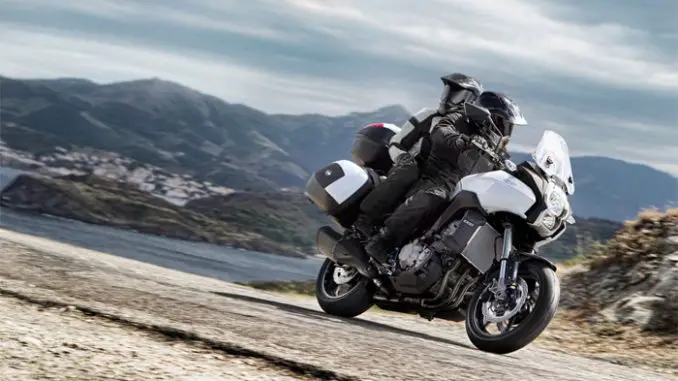
Back to 2012 Kawasaki Motorcycle Model Review Page
Click photos to enlarge. They make great desktop images.
– 2012 Kawasaki Versys 1000
2012 Kawasaki Versys 1000 Review
Roads less travelled
Indulge your desire for discovery and make the journey as exciting as the destination. The new Versys 1000 combines contemporary cutting-edge style with Kawasaki’s unique engineering approach. Enjoy the roads less travelled and realise your distance dreams on the adaptable multi-purpose Versys 1000.
Versys 1000 extends Kawasaki any-street promise
The Versys gets bigger brother for 2012. Answering the demand from riders looking for a dynamic machine in this category, Kawasaki now takes another bold step in the multi-purpose market with the new Versys 1000.
Created as the long-awaited big brother of Kawasaki’s mid-size any-road street surfer, the new Versys 1000 is designed to enable the greatest riding enjoyment in the widest variety of street riding situations. Whether riding solo or two-up, around the corner or around the globe, its unique combination of a highly responsive In-Line Four engine tuned for flexibility, and a nimble chassis fitted with dynamic suspension will answer the evolving needs of many existing Kawasaki customers and look set to draw others to the brand for the very first time. With the Versys 1000, Kawasaki extends its any-street promise to the litre-bike class.
EXTENDING THE ANY-STREET PROMISE TO THE LITRE-BIKE CLASS
Created as the long-awaited big brother of Kawasaki’s mid-size any-road street surfer, the new Versys 1000 is designed to enable
the greatest riding enjoyment in the widest variety of street riding situations. Whether riding solo or two-up, around the corner or around the globe, its unique combination of a highly responsive In-Line Four engine tuned for flexibility, and a nimble chassis fitted with dynamic suspension will have riders grinning in their helmets. With the Versys 1000, Kawasaki extends its anystreet promise to the litre-bike class.
“ANY-STREET ANY-TIME” CHASSIS
When designing the Versys 1000, chassis balance and suspension settings were all selected to maximise rider enjoyment on the street. With its superb control and feedback, the Versys 1000 offers a high level of rider confidence in numerous street riding situations and accommodates a variety of riding styles. And because real world riding occurs on streets that are often less than circuit smooth – road imperfections (bumps, potholes) are far from rare, and some streets are not even paved (cobblestone, etc) – Kawasaki engineers chose long-travel suspension to enable riders to carve corners with aplomb. While not designed for off-road use, the long-travel suspension’s ability to cope with less-than-perfect street conditions allows the Versys 1000 to remain composed where bikes with stiffer, sportier set-ups would need to back off the throttle. The almost zen-like serenity is complemented by a relaxed, upright riding position that offers a high level of machine control as well as a good vantage ahead. A nimble aluminium chassis and sporty 17” wheels enable aggressive sport riding when the mood suits.
Next-generation KYB 43 mm Inverted Fork
* Fixing the cylinder inside the fork inner tube allows a larger cylinder diameter to be achieved: 25 mm (compared to 20 mm on a conventional fork). The larger piston size contributes to a very composed suspension action.
* Because the cylinder itself does not need to be as rigid (fixing the head of the cylinder provides greater rigidity), its walls could be made thinner (t1.0 mm vs t2.0 mm), resulting in a lighter fork (205 g lighter per set).
* The fork’s rebound (upper) and compression (lower) dampers both use reverse damping-force assistance (sub) valves in addition to standard check (main) valves. These valves opposite the check valves ensure that when the fork direction changes (from compression to rebound, or vice versa), oil flow in the reverse direction is also controlled. (Standard forks features uni-directional check valves: controlling either rebound or compression damping. However, when oil flow reverses direction, oil can flow through the valve unchecked during the instant it takes for the check valve to close completely, resulting in a temporary loss in damping force.) The reverse damping-force assistance valves help to reduce this effect, enabling more consistent damping performance, which translates to smoother fork action.
* Long travel of 150 mm contributes to the fork’s excellent bump absorption and road holding performance.
* The fork is adjustable for rebound damping (right-side only) and preload.
* Fork outer tubes vary depending on the model colour: they are gold on the GRY model, silver on the WHT.
* Setting the caster angle at 27° contributes to a good balance of high-speed stability and a neutral handling character that facilitates sporty street riding.
Horizontal Back-link Rear Suspension
Rear suspension positions the shock unit and linkage above the swingarm.
* This arrangement frees up space that would be taken up by the lower linkage of a conventional Uni-Trak suspension. This enables a larger pre-chamber, which in turn allows the use of a shorter muffler, contributing to mass centralisation.
* The suspension is located far enough from the exhaust that operation is not affected by heat.
* The long-travel rear suspension has a stroke of 150 mm.
* The high-spec shock unit features a free piston that separates gas and oil for high-level, stable performance.
* A remote preload adjuster means changes to suit tandem riding or luggage can be made quickly and easily by hand. The rear shock is also adjustable for rebound damping.
Relaxed, Upright Riding Position
* Wide, rigid-mount handlebar offers easy control, especially for low-speed manoeuvring. Positioned to offer a natural grip, it allows the rider’s elbows to be slightly bent when sitting in a relaxed, upright stance.
* The seat’s slim design and the knee grip characteristics of the tank afford good freedom of movement, allowing the riders to change sitting position should they so choose. Thick urethane increases comfort and contributes to a seat height that places the rider in a position of fun controllability. The stepped shape of the seat also provides support for the rider when accelerating.
* Footpegs are positioned lower and further forward (compared to the Z1000), contributing to a spacious riding position.
* Together, all these points result in a very natural, relaxed position designed to offer the rider a high level of machine control. The upright riding position accommodates a variety of riding styles (lean-in, lean-with, lean-out), broadening the spectrum of riding enjoyment and also offers a high level of comfort, a great benefit for touring. This combination of comfort and control is one of the things that make the Versys 1000 so much fun to ride.
* When combined with the long-stroke suspension, the upright riding position and higher seat height offer a commanding view of the road ahead – especially advantageous when navigating city traffic or winding roads in the hills.
Aluminium Twin-tube Frame
* Aluminium twin-tube frame design features frame beams that go over engine, allowing a narrow construction that is easy to grip with the knees.
* Lightweight and highly rigid, the frame uses the engine as a stressed member. The frame contributes to handling, offering a firm, planted feeling, good stability and light, nimble turning.
* The frame is a 5-piece cast aluminium construction, consisting of steering stem, left and right main frames, and two cross pieces. The two main frame components have open C-shaped cross sections and were die-cast to ensure a smooth surface finish.
Aluminium Twin-tube Frame
* Reinforcing pipes join the engine hangers, offering increased chassis rigidity to suit the long-suspension frame configuration.
* As much as possible welds were eliminated, contributing to appearance.
* The frame uses 4 engine mounts. All engine mounts are rigid except the upper rear crankcase mount, which is rubber. This, and using the engine as a stressed member, is what gives the frame its excellent handling characteristics.
* Feeling from the engine is also transmitted more directly to the rider.
* Rear frame is a steel pipe trellis unit that enables the Versys 1000’s high payload.
Sporty 17” Wheels & Multi-purpose Tires
* Lightweight 6-spoke wheels measure 17” – ideal for sporty street riding.
* Wheel colour varies with model colour: on GRY models the wheels are magnesium coloured, on WHT models they are black.
* Pirelli Scorpion Trail tires are matched to the chassis, offering excellent stability at highway speeds and good grip on a variety of street surface conditions.
Triple Petal Disc Brakes with Latest-spec ABS
* 300 mm front petal discs gripped by opposed 4-piston calipers offer strong stopping power with good brake touch and feel.
* At the rear a 250 mm petal disc is slowed by a single-piston caliper.
* ABS is a standard feature on all Versys 1000 models.
* The ABS unit is the same ultra-compact lightweight BOSCH unit used on the 2011 Ninja ZX-10R – the world’s smallest and lightest ABS unit. The high-spec unit enables high-precision ABS control.
* Like on the Ninja ZX-10R, front brake hydraulic pressure is monitored to help control rear wheel lift.
* True to the Versys 1000’s envisioned riding environment, ABS settings are designed to facilitate controlled braking in a variety of street riding situations.
IN-LINE FOUR EXHILARATION
To maximise the Versys 1000’s fun factor, engineers wanted to provide the most exciting engine possible. The engine needed to deliver more than just performance figures. The engine they chose was a 1,043cc In-line Four, tuned for flexibility. Superb throttle response, strong torque at all rpm (especially in the low-mid range), and a seductive intake howl ensure that every twist of the throttle delivers a physical and aural sensation that riders may easily find addictive.
Exciting Engine
* Liquid-cooled, DOHC, 16-valve 1,043 cc In-line Four with a bore and stroke of 77.0 x 56.0 mm offers strong low-mid range torque with smooth power delivery. Compared to the Z1000, the engine delivers a stronger low-mid range with a slightly reduced peak power. Both peak power and torque occur at lower rpm than on the Z1000.
* A number of key differences from the Z1000 engine help achieve the lower-focused engine performance: Compression ratio is 10.3:1 (down from 11.8:1) care of a new combustion chamber. IN/EX cam profiles have shorter duration and reduced lift. (Valves and springs are also unique to the Versys 1000.)
* Downdraft throttle bodies allow intake air to travel to the engine in the shortest possible distance, contributing to performance. While downdraft throttle bodies often use short intake funnels to maximise high-rpm performance, the Versys 1000’s are longer to offer the best power characteristics for street riding excitement.
* Throttle bore is ø38 mm, chosen for low-mid range response.
* Oval sub-throttles are used to deliver extremely smooth response. The oval sub-throttles also help keep the engine slim – important since the throttle bodies are positioned between the rider’s knees.
* An intoxicating intake howl contributes to the engine feel and tempts riders to twist the throttle just to enjoy the aural sensation when accelerating.
* Good over-rev characteristics mean that power does not drop off suddenly at high rpm.
* Power delivery is quite linear and, thanks to FI settings, response is both quick and silky smooth. Both characteristics facilitate control (especially for low-rpm manoeuvres or when rolling the throttle back on) and contribute to sport riding potential.
* Flexible engine character means the Versys 1000 will be just as happy cruising along at low-rpm as it is being ridden more aggressively in the mid-high rpm range.
* A secondary balancer, driven off a gear on the 6th web of the crankshaft, eliminates excess vibration. Of course, a certain amount of engine vibration was desired as part of the bike’s character (vibration contributes to the feeling of acceleration, increasing linearly with rpm), so vibration was not totally eliminated.
Exhaust System
* Large, oval-shaped connector pipes join exhaust headers 1-4 and 2-3, contributing to better performance at all rpm. (The reduced exhaust resistance results in an ideal exhaust flow.)
* Under-engine pre-chamber contributes to a more centralised mass by enabling a smaller-volume silencer.
* Single side muffler offers lower weight than twin mufflers.
Gearing
* Gear ratios were chosen to accommodate a wide range of riding situations, including sport riding, highway cruising, and riding fully loaded with passenger and luggage.
* Compared to the Z1000, 1st and 2nd gears feel shorter (the shorter gearing facilitates moving off from a stop when fully loaded), while 3rd-6th gears are longer (ratios selected to enable sport riding as well as relaxed highway cruising).
RIDE LONG. RIDE FAR.
In addition to the riding excitement offered by the nimble chassis and exhilarating engine, the Versys 1000 offers the comfort and carrying capacity to allow riders to ride long and far. A highly comfortable seat and good wind protection complement the relaxed riding position, making it easy to spend a long time in the saddle. Passenger comfort is also superb, so riders can easily share the fun. A high payload and accessory luggage let riders get away for more than a day at a time. And a large-volume fuel tank and great fuel economy allow a greater range between fill-ups.
Rider & Passenger Comfort
* Thickly padded seat (about double the cushioning of the Z1000 seat) provides the comfort to enable 1000+ kms in the saddle.
* The rear seat has even deeper cushioning, and is probably Kawasaki’s most comfortable passenger perch.
* Seat leather material was carefully selected and a great deal of effort was spent to ensure a good fit. The front seat uses different material than the sides and rear. A two-tone design is used on WHT models.
* Spacious riding position is complemented by footpegs with (hollow) rubber coatings. Footpeg brackets are also rubber mounted to further dampen vibrations.
* Ergonomic grab bars provide comfortable passenger grips.
* Lightweight clutch springs reduce lever effort, contributing to reduced rider fatigue.
Wind Protection
* Adjustable windscreen has a stepless range of approximately 30 mm. Height can be adjusted without tools (using two knobs on the front of the screen) to suit rider preference.
* Functional bodywork was designed to offer increased wind protection. Complementing the windscreen, voluminous front cowling sides and flared side fairings help protect the rider’s legs, further contributing to rider comfort.
High Payload & Carrying Capacity
* Robust steel pipe rear frame enables the substantial payload of 220 kg – plenty for carrying a passenger and luggage.
* A lightweight resin-construction rear carrier (6 kg maximum capacity) is fitted as standard equipment.
* Accessory top-case (and mount) can be fitted. The top case is rated for 3 kg.
* In addition to the top-case, specially designed large-volume GIVI panniers are available as accessories. Each pannier can hold a full-face helmet and is rated for 5 kg. Top-case and panniers can be used simultaneously.
* Taillight and rear turn signals are positioned for good visibility even when using the top-case and panniers.
* Large under-seat storage space has room for compact rain gear or other small items. Tool kit is affixed to the bottom of the seat.
Accessory Support
* High capacity generator develops enough electricity to power a 45 W accessory DC socket. The DC socket can be used to power small electronic devices.
Large-volume Fuel Tank
* 21 L fuel tank contributes to the Versys 1000’s touring potential. With engine and transmission settings, range (calculated) on one tank could be 400 km.
* New-design fuel gauge inside the fuel tank enables a very precise estimation of remaining range. By displaying an average reading, slopes do not affect the reading.
High Fuel Efficiency
* Advanced ECU programming contributes to the Versys 1000’s high fuel efficiency. Careful adjustment of fuel volume and ignition timing when speed is constant improves fuel consumption without compromising driveability.
ADVANCED ELECTRONIC RIDING AIDS
The Versys 1000 is equipped with a number of systems designed to offer additional rider reassurance. KTRC (the same traction control system featured on our supersport flagship, the 2012 Ninja ZX-14R) and power mode can both be set to suit rider preference and conditions.
3-Mode KTRC (Kawasaki TRaction Control)
Featuring the same system offered on the 2012 Ninja ZX-14R flagship, the Versys 1000 KTRC system combines the best elements of Kawasaki’s two traction control systems, S-KTRC and KTRC. Three modes cover a wide range of riding conditions, offering either enhanced sport riding performance or the peace of mind to negotiate slippery surfaces with confidence.
* Riders can choose from three modes. Modes 1 and 2 prioritise maximum forward acceleration (like the S-KTRC system on the 2011 Ninja ZX-10R). Mode 3 is similar to the KTRC system offered on the 2010 1400GTR ABS (Concours 14 ABS), providing rider reassurance by facilitating smooth riding on slippery surfaces. Riders may also elect to turn the system off.
* Compared to the three modes offered by the Ninja ZX-10R’s S-KTRC (which was designed to allow riders to enjoy experimenting with various combinations of settings as they tune their bike for particular corners on the circuit), the effects of Modes 1, 2 and 3 are much easier to distinguish and cover a much wider range of riding conditions.
* In Modes 1 and 2, highly sophisticated programming allows a degree of slip – a certain amount of slip is required to maximise acceleration. The ideal slip ratio varies according to conditions. The system looks at a number of parameters to get an accurate real-time picture of what is going on: front and rear wheel speed (slippage) and various engine, machine and rider input parameters are monitored.
* Using complex analysis, the system is able to predict when traction conditions are about to become unfavourable. By acting before slippage exceeds the range for optimal traction, drops in power can be minimised, resulting in ultra-smooth operation.
* Conditions are confirmed every 5 milliseconds, and control via ignition timing allows extremely quick reaction.
In Mode 3 (the most intrusive) the same logic and control as in Modes 1 and 2 is employed during normal operation. However, when excessive rear wheel spin is detected, Mode 3 switches to three-way control – governing ignition timing, fuel delivery and airflow (via the sub-throttles) – and engine output is reduced to a level that allows the rear wheel to regain grip. It is the control of the sub-throttles that enables smooth operation. This fine control results in a very natural feeling: engagement is smooth, on/off transition is smooth, and stability is maintained during extended operation. (While the KTRC offered on the 1400GTR purposely delayed intervention to let riders know the rear wheel was spinning, intervention in Mode 3 is essentially delay-free.)
* In Mode 3, KTRC effectively enables riders to negotiate both short slippery patches (such as train tracks or manhole covers) and extended stretches of bad road (e.g. wet pavement, cobblestone, gravel, etc) without worry. Wheel spin is also limited when starting on a slippery surface.
* The system is also able to distinguish between torque wheelies, which are smooth, and sudden wheelies, which can be dangerous. In Modes 1 and 2, torque wheelies are allowed as long as acceptable acceleration is maintained. Sudden wheelies trigger system intervention. In Mode 3, all wheelies are prevented.
* The system uses minimal hardware but complex software. Apart from the engine ECU, the system relies on only front and rear wheel speed sensors – which means minimal additional weight (none, in the case of ABS models, which already have wheel speed sensors).
* By default, KTRC is always ON when the engine is started. (The mode will be the same as when the engine was turned off, or in Mode 1 if the system had been turned off.) Riders must consciously turn the system off (using the on/off button on the left grip).
Power Mode Selection
A choice of Full Power or Low Power modes allows riders to set power delivery to suit preference and conditions. Low Power mode limits output to approximately 75% of Full Power and uses a milder throttle response. (Reduction of both power and throttle response varies according to engine speed (rpm), throttle position and gear position.)
* Combining the various KTRC and Power Mode options, riders have eight combinations from which to choose. For example, an experienced rider on dry pavement might choose Full Power and KTRC Mode 1 for sport riding. On a wet and/or slippery road surface, Low Power and KTRC Mode 3 might be selected. Each system can be set independently to best suit rider skill/preference, riding location and road conditions.
Instrumentation
* Tough-design multi-function instrumentation includes an analogue-style tachometer and LCD with speedometer, fuel gauge, odometer, clock, dual trip meters, current and average fuel consumption, remaining range, and external air temperature.
* KTRC (3 modes + OFF), Power Mode (2 modes) and the various LCD modes are all controlled using the multi-function button located at the left handle.
* The Economical Riding Indicator appears on the LCD screen to indicate favourable fuel consumption. Paying attention to conditions that result in the mark appearing can assist riders to maximise their fuel efficiency. This handy feature is active all the time, although to be effective, the rider must ride in a gentle manner: less than 6,000 rpm, less than 30% throttle, under 160 km/h.
2012 Kawasaki Versys 1000 Key Features
– Long-travel suspension front & rear allows riders to enjoy sports and touring riding on a variety of streets and conditions
– Upright and very comfortable riding position offers a high level of control with confidence in various situations
– Sporty, nimble handling due to the lightweight aluminium twin-tube frame
– 1,043 cc In-line-four which pulls strongly throughout the entire rev range
– Adjustable windscreen
– Functional and robust bodywork offers high wind protection
– Long range thanks to a 21.5 L fuel tank
– KTRC (Kawasaki TRaction Control)
– 3 modes cover a wide range of conditions
– Power Mode selection
– 2 modes: Full Power + Low Power (about 75% of Full)
– Latest-spec ABS standard
– Robust rear frame designed for heavy payload
– Gears selected for a wide range of riding situations
– 17” wheels: ideal for sport and tour riding
– Numerous genuine accessories
Long-travel suspension front & rear allows riders to enjoy sport riding on a variety of streets and conditions
Upright position offers a high level of control with confidence in various situations
Adjustable windscreen – No tools required
Functional bodywork offers high wind protection
Long range 21 L fuel tank
Wide thick-cushion rear seat
Ergonomic grab bars
Position contributes to relaxed, comfortable riding
Endless revs and howling exhaust note only a 1000cc In-Line Four engine can offer
– 1,043cc
– Strong torque at all rpm (especially in low-mid range)
– Engine keeps on pulling right through high-rpm
Robust rear frame designed for heavy payload
– 220 kg payload plenty for riding with passenger and luggage
– Rear carrier with high load capacity
Gears selected for a wide range of riding situations
Numerous genuine accessories
– Panniers, top-case, grip warmers, DC outlet, hand guards, engine guards, etc
Sporty, nimble handling care of lightweight aluminium twin-tube frame
17” wheels: ideal for sport riding
“ANY STREET, ANY TIME” x KAWASAKI’S IN-LINE FOUR EXHILARATION: ADVANCED TECHNOLOGY
KTRC (Kawasaki TRaction Control)
– 3 modes cover a wide range of conditions
– Increased sport riding performance & enhanced stability in low-grip situations
Power Mode selection
– 2 modes: Full Power + Low Power (about 75% of Full)
Latest-spec ABS standard
– Latest-spec lightweight & compact ABS unit
Low vibration, smooth, difficult to stall
– Smooth, crisp throttle response facilitates low-speed control, ideal for sport riding
2012 Kawasaki Versys 1000 Features and Benefits
Impressive In-Line Four
To maximise the Versys 1000’s fun factor, engineers wanted to provide the most exciting engine possible. The engine needed to deliver more than just performance figures. The engine they chose was a 1,043 cm3 In- line Four, tuned for flexibility. Superb throttle response, strong torque at all rpm (especially in the low-mid range), and a seductive intake howl ensure that every twist of the throttle delivers a physical and aural sensation that riders may easily find addictive.
Power Mode Selection
A choice of Full Power or Low Power modes allows riders to set power delivery to suit preference and conditions. Low Power mode limits output to approximately 75% of Full Power and delivers a milder throttle response. (Reduction of both power and throttle response varies according to engine speed (rpm), throttle position and gear position.)
Aluminium Twin-tube Frame
Aluminium twin-tube frame design features frame beams that go over engine, allowing a narrow construction that is easy to grip with the knees.
Lightweight and highly rigid, the frame uses the engine as a stressed member. The frame contributes to handling, offering a firm, planted feeling, good stability and light, nimble turning. The frame is a 5-piece cast aluminium construction, consisting of steering stem, left and right main frames, and two cross pieces. The two main frame components have open C-shaped cross sections and were die-cast to ensure a smooth surface finish.
Adjustable front fork
The fork is adjustable for rebound damping (right-side only) and preload.
Easy adjustable rear shock
A remote preload adjuster means changes to suit tandem riding or luggage can be made quickly and easily by hand. The rear shock is also adjustable for rebound damping.
ABS brakes
ABS is standard on the Versys 1000. The 300 mm front petal discs are gripped by opposed 4-piston calipers offering strong stopping power with good brake touch and feel. At the rear a 250 mm petal disc is slowed by a single-piston caliper.
Adjustable windscreen
The adjustable windscreen has a stepless range of approximately 30 mm. Height can be adjusted by hand and without tools (using two knobs on the front of the screen) to suit rider preference.
Wide, rigid-mount handlebar
Wide, rigid-mount handlebar offers easy control, especially for low-speed manoeuvring. Positioned to offer a natural grip, it allows the rider’s elbows to be slightly bent when sitting in a relaxed, upright stance.
Rider & Passenger Comfort
Thickly padded seat (about double the cushioning of the Z1000 seat) provides the comfort to enable hundreds of miles in the saddle. The rear seat has even deeper cushioning, and is probably Kawasaki’s most comfortable passenger perch yet. Seat leather material was carefully selected and a great deal of effort was spent to ensure a good fit. The front seat uses different material than the sides and rear. A two-tone design is used on white models.
High Payload & Carrying Capacity
Robust steel pipe rear frame enables the substantial payload of 220 kg
Comfortable passenger grip
Ergonomic grab bars provide comfortable passenger grips.
Large-volume Fuel Tank
21 L fuel tank contributes to the Versys 1000’s touring potential. With engine and transmission settings, range (calculated) on one tank could last up to 250 miles. New-design fuel gauge inside the fuel tank enables a very precise estimation of remaining range. By displaying an average reading, inclines do not affect the reading.
Instrumentation
Tough-design multi-function instrumentation includes an analogue-style tachometer and LCD with speedometer, fuel gauge, odometer, clock, dual trip meters, current and average fuel consumption, remaining range, and external air temperature.
Responsive Engine
Liquid-cooled, DOHC, 16-valve 1,043 cm3 In-line Four with a bore and stroke of 77.0 x 56.0 mm offers strong low-mid range torque with smooth power delivery. Compared to the Z1000, the engine delivers a stronger low-mid range with a slightly reduced peak power. Both peak power and torque occur at lower rpm than on the Z1000.
Downdraft throttle bodies allow intake air to travel to the engine in the shortest possible distance, contributing to performance. While downdraft throttle bodies often use short intake funnels to maximise high-rpm performance, the Versys 1000’s are longer to offer the best power characteristics for street riding excitement.
Power delivery is quite linear and, thanks to refined FI settings, response is both quick and silky smooth. Both characteristics facilitate control (especially for low-rpm manoeuvres or when rolling the throttle back on) and contribute to multi-purpose and sport riding potential.
Flexible engine character means the Versys 1000 will be just as happy cruising along at low-rpm as it is being ridden more aggressively in the mid-high rpm range.
3-Mode KTRC (Kawasaki TRaction Control)
Featuring the same system offered on the 2012 ZZR1400 flagship, the Versys 1000 KTRC system combines the best elements of Kawasaki’s two traction control systems, S-KTRC and KTRC. Three modes cover a wide range of riding conditions, offering either enhanced sport riding performance or the peace of mind to negotiate slippery surfaces with confidence.
Riders can choose from three modes. Modes 1 and 2 prioritise maximum forward acceleration (like the S-KTRC system on the 2011 Ninja ZX-10R). Mode 3 is similar to the KTRC system offered on the 2010 1400GTR, providing rider reassurance by facilitating smooth riding on slippery surfaces. Riders may also elect to turn the system off.
Next-generation KYB 43 mm Inverted Fork
Fixing the cylinder inside the fork inner tube allows a larger cylinder diameter to be achieved: 25 mm (compared to 20 mm on
a conventional fork). The larger piston size contributes to a very composed suspension action.
Horizontal Back-link Rear Suspension
Rear suspension positions the shock unit and linkage above the swingarm. This arrangement frees up space that would be taken up by the lower linkage of a conventional Uni-Trak suspension. This enables a larger pre-chamber, which in turn allows the use of a shorter muffler, contributing to mass centralisation.
Sporty 17” Wheels
Lightweight 6-spoke wheels measure 17” – ideal for this multi-pupose machine while also encouraging sporty street riding.
Multi-purpose Tyres
Pirelli Scorpion Trail tyres are matched to the chassis, offering excellent stability at highway speeds and good grip on a variety of road surface conditions.
Functional bodywork
Functional bodywork was designed to offer increased wind protection. Complementing the windscreen, voluminous front cowling sides and flared side fairings help protect the rider’s legs from the elements, further contributing to rider comfort.
Slim design seat
The seat’s slim design and the knee grip characteristics of the tank afford good freedom of movement, allowing the riders to change sitting position should they so choose. Thick urethane increases comfort and
contributes to a seat height that places the rider in a position of controllability. The
stepped shape of the seat also provides support for the rider when accelerating.
Rubber coated footpegs
Spacious riding position is complemented by
footpegs with (hollow) rubber coatings. Footpeg brackets are also rubber mounted to
further dampen vibrations.
Lightweight rear carrier
A lightweight resin-construction rear carrier (6 kg maximum capacity) is fitted as standard equipment. Accessory top-case (and mount) can be fitted.
Taillight
Taillight and rear turn signals are positioned for good visibility even when using the optional top-case and panniers.
High Fuel Efficiency
Advanced ECU programming contributes to the Versys 1000’s high fuel efficiency. Careful adjustment of fuel volume and ignition timing when speed is constant improves fuel consumption without compromising driveability.
The Economical Riding Indicator appears on the LCD screen to indicate favourable fuel consumption. Paying attention to conditions that result in the mark appearing can assist riders to maximise their fuel efficiency. This handy feature is active all the time, although to be effective, the rider must ride in a gentle manner: less than 6,000 rpm, less than 30% throttle and under 160 km/h.
2012 Kawasaki Versys 1000 Accessories
PANNIERS 2x35L
HANDGUARDS
COVER TOP CASE 47L
BACKREST PAD TOP CASE 47L
2012 Kawasaki Versys 1000 – USA Specifications/Technical Details
US MSRP Price: NA
Model not available in the USA
2012 Kawasaki Versys 1000 – Canadian Specifications/Technical Details
Canada MSRP Price: $13,999 CDN
KLZ1000ACF
Engine
Type 4-stroke In-Line Four
Displacement 1043cc
Bore and Stroke 77.0 x 56.0 mm
Cooling Liquid
Compression Ratio 10.3:1
Valve System DOHC, 16 valves
Fuel system Digital fuel injection with four 38 mm Keihin throttle bodies
Ignition Digital
Lubrication Forced lubrication, wet sump
DRIVETRAIN
Top
Transmission 6-speed, return
Final Drive Sealed chain
Primary Reduction Ratio 1.627 (83/51)
Gear Ratio: 1st 2.692 (35/13)
Gear Ratio: 2nd 1.950 (39/20)
Gear Ratio: 3rd 1.529 (26/17)
Gear Ratio: 4th 1.304 (30/23)
Gear Ratio: 5th 1.136 (25/22)
Gear Ratio: 6th 0.958 (23/24)
Final Reduction Ratio 2.867 (43/15)
Clutch Wet multi-disc, manual
FRAME
Top
Type Aluminium twin-tube
Wheel Travel: Front 150 mm
Tire: Front 120/70ZR17M/C (58W)
Wheel Travel: Rear 150 mm
Tire: Rear 180/55ZR17M/C (73W)
Caster (Rake) 27°
Trail 107 mm
Steering Angle (Left/Right) 34° / 34°
SUSPENSION
Top
Suspension, Front 43 mm inverted fork with stepless rebound damping and spring preload adjustability
Suspension, Rear Horizontal Back-link, gas-charged, with stepless rebound damping and remote spring preload adjustability
BRAKES
Top
Front: Type Dual semi-floating 300 mm petal discs
Front: Calipers Dual opposed 4-piston
Rear: Type Single 250 mm petal disc
Rear: Caliper Single-piston
DIMENSIONS
Top
Overall Length 2,235 mm
Overall Width 900 mm
Overall Height 1,405 mm / 1,430 mm
Wheelbase 1,520 mm
Ground Clearance 155 mm
Seat Height 845 mm
Curb Mass** 239 kg
Fuel Capacity 21 litres
** Includes all necessary materials and fluids to operate correctly, full tank of fuel (more than 90% of capacity) and tool kit (if supplied)
PERFORMANCE
Top
Maximum Power‡ 86.8 kW {118 PS} @ 9,000 rpm
Maximum Torque‡ 102 N.m {10.4 kgf.m} @ 7,700 rpm
‡ Power / Torque figures measured at the crankshaft.
DETAILS
Top
Warranty 12 months warranty
ADDITIONAL COST OPTIONS
Top
Good Times Protection Plan 24 or 36 months (Kawasaki GTPP coverage begins after the standard limited warranty expires)
MSRP*
Top
Metallic Magnesium GrayKLZ1000ACF $13,999
2012 Kawasaki Versys 1000 – UK/European Specifications/Technical Details
UK/EU MSRP Price: See UK/European Kawasaki Dealer for pricing.
Engine
Fuel system
Fuel injection: ø38 mm x 4 (Keihin) with oval sub-throttles
Ignition
Digital
Starting
Electric
Lubrication
Forced lubrication, wet sump
Engine type
Liquid-cooled, 4-stroke In-Line Four
Displacement
1,043 cm³
Bore x stroke
77.0 x 56.0 mm
Compression ratio
10.3:1
Valve/Induction system
DOHC, 16 valves
Transmission
Clutch
Wet multi-disc, manual
Primary reduction ratio
1.627 (83/51)
Gear ratios: 1st
2.692 (35/13)
Gear ratios: 2nd
1.950 (39/20)
Gear ratios: 3rd
1.529 (26/17)
Gear ratios: 4th
1.304 (30/23)
Gear ratios: 5th
1.136 (25/22)
Gear ratios: 6th
0.958 (23/24)
Final reduction ratio
2.867 (43/15)
Transmission
6-speed, return
Final Drive
Sealed chain
Frame
Frame type
Aluminium twin-tube
Rake/Trail
27? / 107 mm
Wheel travel, front
150 mm
Wheel travel, rear
150 mm
Tyre, front
120/70ZR17M/C (58W)
Tyre, rear
180/55ZR17M/C (73W)
Steering angle, left / right
34? / 34?
Suspension
Suspension, front
43 mm inverted fork with stepless
rebound damping and spring preload
adjustability
Suspension, rear
Horizontal Back-link, gas-charged,
with stepless rebound damping and
remote spring preload adjustability
Brakes
Brakes, front
Dual semi-floating 300 mm petal discs
Caliper: Dual opposed 4-piston
Brakes, rear
Single 250 mm petal disc
Caliper: Single-piston
Dimensions
Dimensions (L x W x H)
2,235 mm x 900 mm x 1,405 mm / 1,430 mm
Ground Clearance
155 mm
Wheelbase
1,520 mm
Seat height
845 mm
Fuel capacity
21 litres
Curb Mass
239 kg
Performance
Maximum power
86.8 kW {118 PS} / 9,000 rpm
Maximum torque
102 N.m {10.4 kgf.m} / 7,700 rpm
2012 Kawasaki Versys 1000 – Australia Specifications/Technical Details
AU MSRP Price:
Engine
Type Liquid-cooled, 4-stroke In-Line Four
Displacement 1,043 cm³
Bore and Stroke 77 x 56 mm
Compression ratio 10.3:1
Valve system DOHC, 16 valves
Fuel system Fuel injection: Ø 38 mm x 4 (Keihin) with oval sub-throttles
Ignition Digital
Starting Electric
Lubrication Forced lubrication, wet sump
Drivetrain
Transmission 6-speed, return
Final drive Sealed Chain
Primary reduction ratio 1.627 (83/51)
Gear ratios: 1st 2.692 (35/13)
2nd 1.950 (39/20)
3rd 1.529 (26/17)
4th 1.304 (30/23)
5th 1.136 (25/22)
6th 0.958 (23/24)
Final reduction ratio 2.867 (43/15)
Clutch Wet multi-disc, manual
Frame
Type Aluminium twin-tube
Wheel travel: front 150 mm
rear 150 mm
Tyre: front 120/70ZR17M/C (58W)
rear 180/55ZR17M/C (73W)
Caster (rake) 27°
Trail 107 mm
Steering angle (left/right) 34° / 34°
Suspension
Front: Type 43 mm inverted telescopic fork with stepless (right-side) adjustable rebound damping and adjustable preload
Rear: Type Horizontal Back-link, gas-charged with stepless rebound damping and remote spring preload adjuatability
Brakes
Front: Type Dual semi-floating 300 mm petal discs
Caliper Dual opposed 4 piston with ABS
Rear: Type Single 250 mm petal disc
Caliper Single-piston with ABS
Dimensions
Overall length 2,235 mm
Overall width 900 mm
Overall height 1,405 mm/ 1,430 mm (with windscreen raised)
Wheelbase 1,520 mm
Ground clearance 155 mm
Seat height 845 mm
Curb mass 239 kg (Includes full fuel tank)
Fuel capacity 21 litres
Performance
Maximum power 86.8 kW {118 PS} / 9,000 rpm
Maximum torque 102 N·m {10.4 kgf·m} / 7,700 rpm


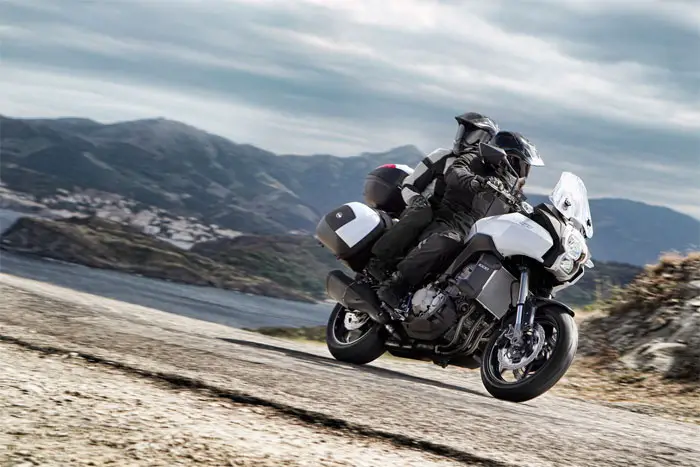
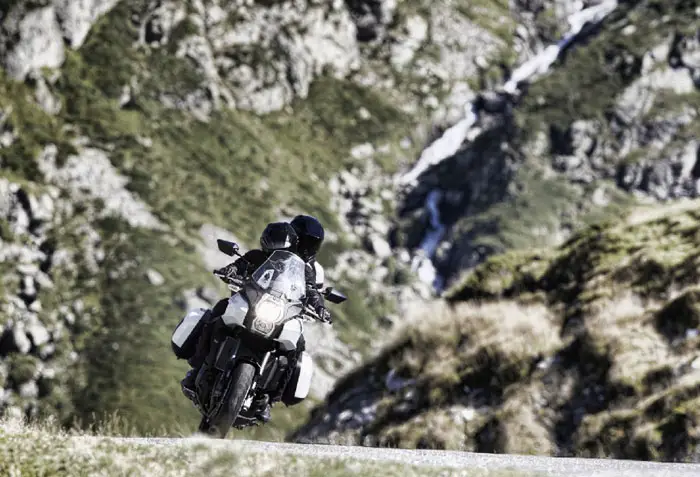
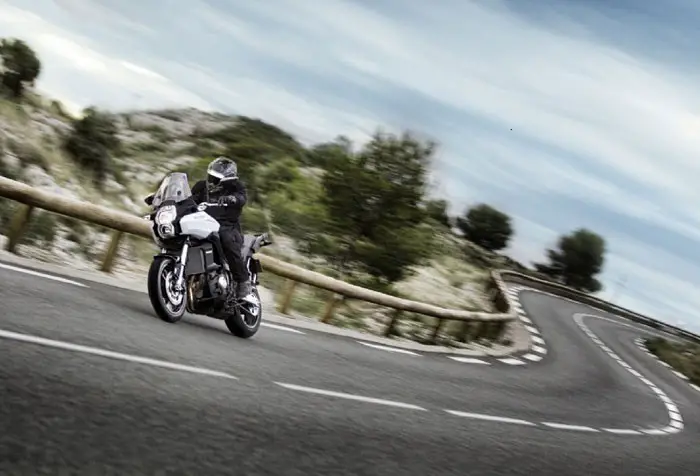
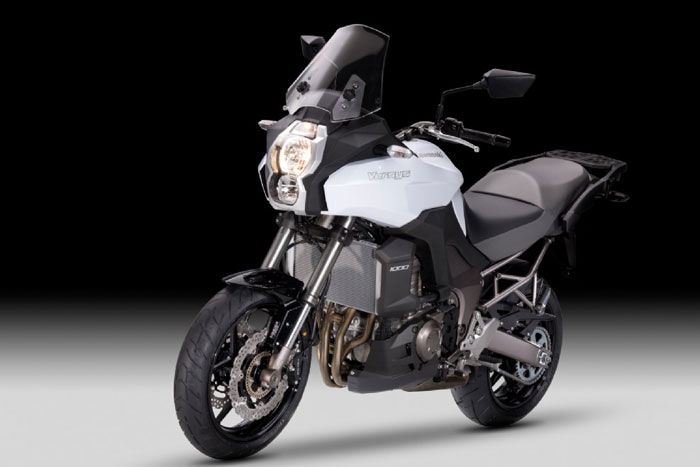
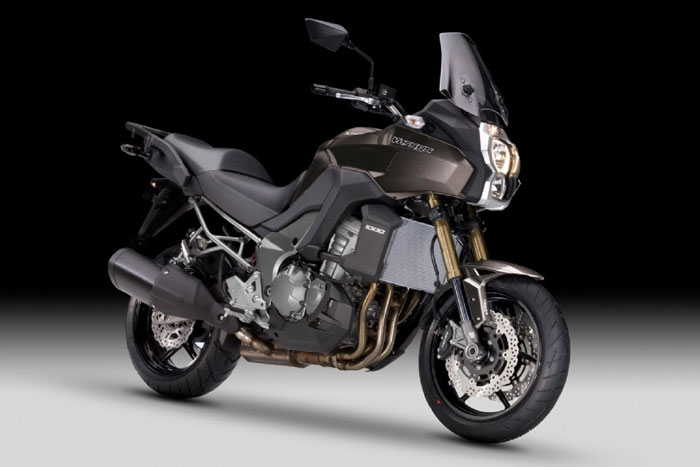
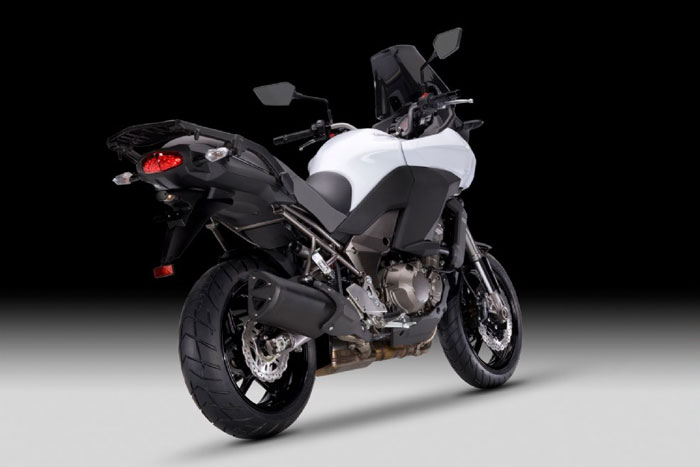
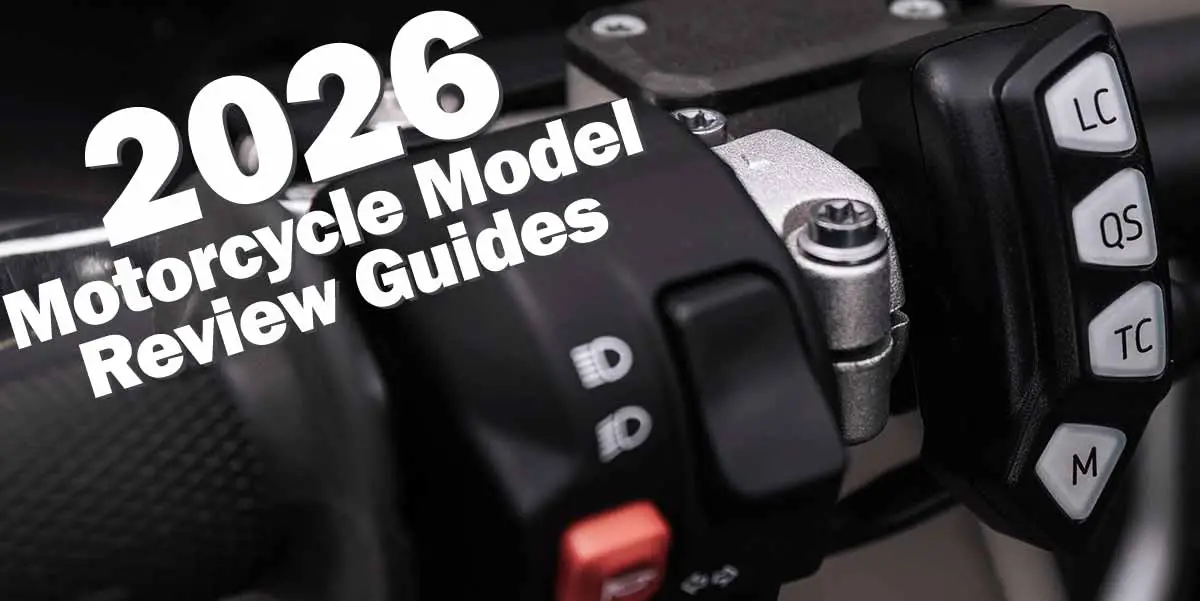
Be the first to comment